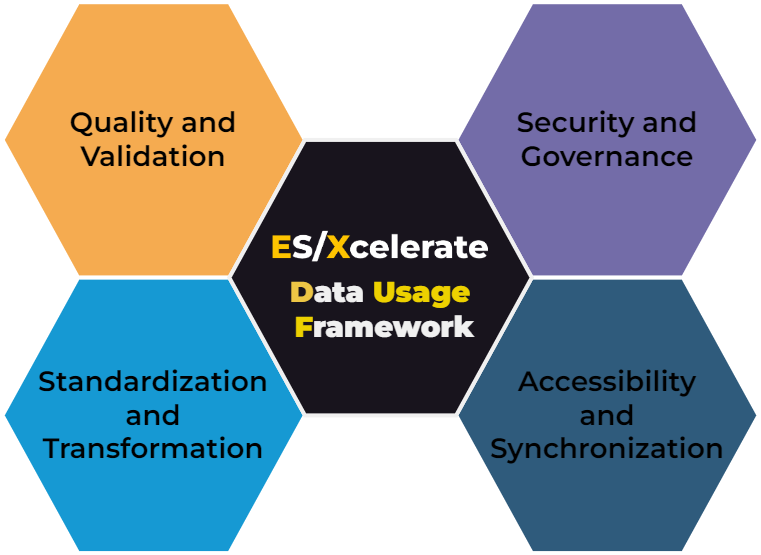Data is the lifeblood of any modern organization, and how it is used can make or break its success. Data usage is the process of transforming raw data into meaningful insights that can drive business decisions, actions, and outcomes. Data usage is a crucial component of data engineering and data architecture, as it determines how data is accessed, analyzed, and visualized by various users and roles across the organization.
To enable effective data usage, it is essential to have a clear and consistent framework that guides the design, implementation, and governance of data integration solutions. A framework provides a common language, a set of principles, and a roadmap for achieving the desired data usage goals and objectives. A framework also helps to ensure data quality, security, and compliance, as well as to measure and improve data usage maturity and performance.
One such framework is the ES/Xcelerate Data&AI Usage Framework, developed by Nilay Parikh at ErgoSum / X Labs. This framework is based on the ES/Xcelerate Data&AI, a comprehensive Enterprise Framework that enables data-driven excellence for organizations of any size and industry. The framework aims to help solution architects, technology leaders, enterprise architects, team leads, and senior software engineers to design and deliver data integration solutions that meet the needs and expectations of their stakeholders.

© Nilay Parikh. All rights reserved. No warranty or liability implied.
The ES/Xcelerate Data&AI Usage Framework is a powerful and practical tool that can help data professionals to design and deliver data integration solutions that are aligned with the business goals, data-driven excellence, and data usage principles. By using the framework, data professionals can ensure that their data integration solutions are effective, efficient, and scalable, as well as trustworthy, credible, and evidence-based. The framework can also help data professionals to assess and improve their data usage maturity and capabilities, as well as to demonstrate their value and impact to their stakeholders.
| Principle | Description |
| Quality and Validation | Data quality refers to the accuracy, completeness, consistency, and reliability of the data. Data quality is essential for ensuring the validity and usefulness of the data for various purposes. Data quality can be ensured by implementing validation, cleansing, enrichment, and normalization processes during data integration. |
| Security and Governance | Data governance is the set of policies, standards, roles, and responsibilities that define how data is managed, accessed, and used within an organization. Data governance helps to ensure data security, privacy, compliance, and quality. Data governance also facilitates data collaboration and communication among different stakeholders. |
| Standardization and Transformation | Data standardization is the process of transforming data from different sources into a common format and structure that can be easily integrated and analyzed. Data standardization helps to eliminate data silos, reduce data complexity, and improve data interoperability. |
| Accessibility and Synchronization | Data accessibility is the degree to which data is available and usable by authorized users and roles across the organization. Data accessibility enables data discovery, exploration, analysis, and visualization for various purposes. Data accessibility can be achieved by implementing data integration technologies, such as data consolidation, data virtualization, and data replication. |

Executive layer, providing succinct architectural insights through graphical representations and value-driven roadmaps. Align organizational data strategies with business goals, offering transparent views of budgetary, risk, and capability trade-offs.

Design layer for comprehensive architectural principles, design patterns, and technical recommendations. Tailored for architects and engineers, it guides through modern best practices, balancing quality, cost, and agility for robust implementations.

Data governance teams find their compass in the Controls layer, offering predefined audit controls, risk indicators, and capability maturity blueprints. Quantify operational metrics, ensuring a rigorous approach to quality, compliance, and usage across data processes.
License
This work (ES/Xcelerate Framework) by Nilay Parikh is licensed under CC BY 4.0 or view a human-readable summary.
If the above licenses do not suit your needs, please contact us at [email protected] to discuss your terms. We also offer more flexible commercial license that do not require attribution. The different licensing approaches reflect the intellectual property and commercial considerations associated with various framework elements while still promoting access.
Disclaimer
The views expressed on this site are personal opinions only and have no affiliation. See full disclaimer, terms & conditions, and privacy policy. No obligations assumed.
